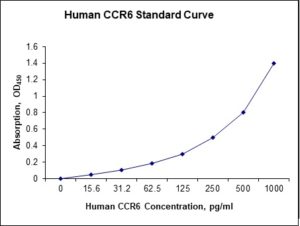Nori Human CCR6 ELISA Kit
$461.00 – $832.00
This ELISA kit is for quantification of CCR6 in human. This is a quick ELISA assay that reduces time to 50% compared to the conventional method, and the entire assay only takes 3 hours. This assay employs the quantitative sandwich enzyme immunoassay technique and uses biotin-streptavidin chemistry to improve the performance of the assays. An antibody specific for CCR6 has been pre-coated onto a microplate. Standards and samples are pipetted into the wells and any CCR6 present is bound by the immobilized antibody. After washing away any unbound substances, a detection antibody specific for CCR6 is added to the wells. Following wash to remove any unbound antibody reagent, a detection reagent is added. After intensive wash a substrate solution is added to the wells and color develops in proportion to the amount of CCR6 bound in the initial step. The color development is stopped, and the intensity of the color is measured.
Alternative names for CCR6: Chemokine receptor 6 (CCR6), CD196
This product is for laboratory research use only not for diagnostic and therapeutic purposes or any other purposes.
- Description
- How Elisa Works
- Product Citation ()
- Reviews (0)
Description
Nori Human CCR6 ELISA Kit Summary
Alternative names for CCR6: Chemokine receptor 6 (CCR6), CD196
| Assay Type | Solid Phase Sandwich ELISA |
| Format | 96-well Microplate or 96-Well Strip Microplate |
| Method of Detection | Colorimetric |
| Number of Targets Detected | 1 |
| Target Antigen Accession Number | P51684 |
| Assay Length | 3 hours |
| Quantitative/Semiquantitative | Quantitative |
| Sample Type | Plasma, Serum, Cell Culture, Urine, Cell/Tissue Lysates, Synovial Fluid, BAL, |
| Recommended Sample Dilution (Plasma/Serum) | No dilution for sample <ULOQ; sufficient dilution for samples >ULOQ |
| Sensitivity | 3 pg/mL |
| Detection Range | 15.6-1000 pg/mL |
| Specificity | Natural and recombinant human CCR6 |
| Cross-Reactivity | < 0.5% cross-reactivity observed with available related molecules, < 50% cross-species reactivity observed with species tested. |
| Interference | No significant interference observed with available related molecules |
| Storage/Stability | 4 ºC for up to 6 months |
| Usage | For Laboratory Research Use Only. Not for diagnostic or therapeutic use. |
| Additional Notes | The kit allows for use in multiple experiments. |
Standard Curve
Kit Components
1. Pre-coated 96-well Microplate
2. Biotinylated Detection Antibody
3. Streptavidin-HRP Conjugate
4. Lyophilized Standards
5. TMB One-Step Substrate
6. Stop Solution
7. 20 x PBS
8. Assay Buffer
Other Materials Required but not Provided:
1. Microplate Reader capable of measuring absorption at 450 nm
2. Log-log graph paper or computer and software for ELISA data analysis
3. Precision pipettes (1-1000 µl)
4. Multi-channel pipettes (300 µl)
5. Distilled or deionized water
Protocol Outline
1. Prepare all reagents, samples and standards as instructed in the datasheet.
2. Add 100 µl of Standard or samples to each well and incubate 1 h at RT.
3. Add 100 µl of Working Detection Antibody to each well and incubate 1 h at RT.
4. Add 100 µl of Working Streptavidin-HRP to each well and incubate 20 min at RT.
5. Add 100 µl of Substrate to each well and incubate 5-30 min at RT.
6. Add 50 µl of Stop Solution to each well and read at 450 nm immediately.
Background:
Chemokine receptor 6 (CCR6) is a CC chemokine receptor protein which is encoded by the CCR6 gene.[1] CCR6 has also recently been designated CD196. CCR6 belongs to family A of G protein-coupled receptor superfamily. CCR6 is expressed in lymphatic and non-lymphatic tissues and on multiple cell types.[2] The ligand of this receptor is CCL20 (MIP-3 alpha). This chemokine receptor is special because it binds only one chemokine ligand CCL20 in compare to other chemokine receptors.[3] CCR6 has a key role in connection between immature DC and adaptive immunity.[4] This receptor is critical for B-lineage maturation and antigen-driven B-cell differentiation, and it may regulate the migration and recruitment of dendritic cells and T cells during inflammatory and immunological responses. It can regulate immune response in inflammatory tissue.[5] IL-4 and IFNγ suppress expression of CCR6 in langerhans cells development and IL-10 induces the expression. Proinflammatory Th17 cells express CCR6 and its ligand CCL20. CCR6 influences their migration to sites of inflammation. Some Th17 cells migrate via chemokine gradient of CCL20 to inflammatory sites and themselves can express more CCL20 to bring in more Th17 cells and regulatory T-cells (Treg). This can lead to chronic inflammation. In some models, the lack of CCR6 leads to less severe autoimmune encephalomyelitis.[6] CCR6 has a function in development and metastatic spread of gastrointestinal malignancies.[3] Expression of CCR6 was found to be up-regulated in colorectal cancer.[7] Colorectal carcinoma cells express CCR6 and CCL20. High level of CCL20 in liver chemoattract colorectal carcinoma cells and cause metastases in liver.[3][8] CCR6 has been associated with Crohn’s disease.[9]
References
- Zaballos A, et al. (1996). Biochem. Biophys. Res. Commun. 227 (3): 846–53.
- Schutyser, E, et al. (2003). Cytokine & Growth Factor Reviews. 14 (5): 409–426.
- Frick, Vilma Oliveira; et al. (2016). World Journal of Gastroenterology. 22 (2): 833–841.
- Dieu, M. C.; et al. (1998). The Journal of Experimental Medicine. 188 (2): 373–386.
- Dieu-Nosjean, M-C; et al. (2001). The Journal of Immunology. 167 (10): 5594–5602.
- Yamazaki, Tomohide; et al. (2008). The Journal of Immunology. 181 (12): 8391–8401.
- Rubie, Claudia; et al. (2014). Journal of Translational Medicine. 12: 48.
- Frick, V. O.; et al. (2013). Scandinavian Journal of Immunology. 78 (3): 298–305.
- Wang K, et al. (2009). Am. J. Hum. Genet. 84 (3): 399–405.
Be the first to review “Nori Human CCR6 ELISA Kit”
You must be logged in to post a review.





























Reviews
There are no reviews yet.